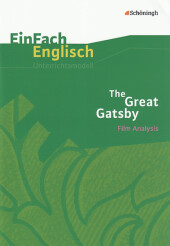 Neuerscheinungen 2010Stand: 2020-01-07 |
Schnellsuche
ISBN/Stichwort/Autor
|
Herderstraße 10
10625 Berlin
Tel.: 030 315 714 16
Fax 030 315 714 14
info@buchspektrum.de |

F. Scott Fitzgerald, F. Scott Fitzgerald, Daniela Woloszczak
(Beteiligte)
F. S. Fitzgerald ´The Great Gatsby´, Film Analysis
Mitarbeit: Woloszczak, Daniela; Vorlage: Fitzgerald, F. Scott
2010. 96 S. 30 cm
Verlag/Jahr: SCHÖNINGH IM WESTERMANN 2010
ISBN: 3-14-041188-X (314041188X)
Neue ISBN: 978-3-14-041188-2 (9783140411882)
Preis und Lieferzeit: Bitte klicken
Verfilmung von 1974.
New York zur Zeit der Roaring Twenties. Gewinner und Verlierer der New Yorker Gesellschaft gleichermaßen tummeln sich jeden Sommer auf den rauschenden Tanzpartys des jungen Selfmade-Millionärs Jay Gatsby. Der zwielichtige Geschäftsmann aus mittellosen Verhältnissen möchte aber eigentlich nur eines: Als "Great Gatsby" seine aus einer vermögenden Familie stammende Jugendliebe Daisy zurückzugewinnen. Diese ist allerdings inzwischen verheiratet ...
Der von Jack Clayton im Jahre 1974 produzierte Film basiert auf dem gleichnamigen Roman von F. Scott Fitzgerald aus dem Jahre 1925. Fitzgeralds Roman gilt als Meisterwerk der amerikanischen Literatur des 20. Jahrhunderts. Der Film zeigt zugleich eine ergreifende Liebesgeschichte und ein ausdrucksstarkes Bild der amerikanischen Gesellschaft des Jazz Age. Vor allem aber ist The Great Gatsby ein Film über die vielen verschiedenen Facetten des American Dream.
Der Film ist geeignet für die Jahrgangsstufen 11 und 12. Dieses Unterrichtsmodell liefert einen praxisorientierten Leitfaden zur Behandlung im Unterricht unter besonderer Berücksichtigung der Förderung von film literacy.
Ebenfalls erschienen ist eine Textausgabe des Romans mit Annotationen und Zusatzaufgaben: Schöningh, Bestell-Nr.: 041190 und dazu ein Unterrichtsmodell zur Analyse des Romans: Schöningh, Bestell-Nr.: 041191.
Contents:
The plot - The characters - Scene index and summary - Vorüberlegungen zum Einsatz des Films im Unterricht - Klausuren - Konzeption des Unterrichtsmodells - Components - Anhang
Component 1: Getting into the film: Entering the world of Mr Gatsby - The Jazz Age
Component 2: Who is who? Characters and conflicts: Completing a character map - Long-term while-viewing task: Characterization - Introducing Jay Gatsby - The dark side of Jay Gatsby
Component 3: A dream has come true? The reunion - film analysis: Daisy and Gatsby´s reunion I & analysing body language - Daisy and Gatsby´s reunion II - Gatsby and Daisy´s past - Living the dream
Component 4: "You can´t repeat the past" - Gatsby´s fight for his dream: Lunch at the Buchanans´: Preparation for the catastrophe - The ride to New York - The fight at the Plaza Hotel - The accident - The dream is over
Component 5: American dreams, American nightmares: Benjamin Franklin: The man who invented the ´American Dream´ - After Gatsby´s death - Reactions to Gatsby´s death - From dream to nightmare
Component 6: Post-viewing activities: The structure of the plot - gallery walk - Writing a screenplay - The autobiographical background of the film
From the contents:
The plot - The characters - Scene index and summary; Vorüberlegungen zum Einsatz des Films im Unterricht; Klausuren; Konzeption des Unterrichtsmodells; Components; Anhang
Component 1: Getting into the film: Entering the world of Mr Gatsby, The Jazz Age
Component 2: Who is who? Characters and conflicts: Completing a character map; Long-term while-viewing task: Characterization; Introducing Jay Gatsby; The dark side of Jay Gatsby
Component 3: A dream has come true? The reunion and film analysis: Daisy and Gatsby´s reunion I - analysing body language; Daisy and Gatsby´s reunion II; Gatsby and Daisy´s past; Living the dream
Component 4: "You can´t repeat the past"; Gatsby´s fight for his dream: Lunch at the Buchanans´: Preparation for the catastrophe, The ride to New York; The fight at the Plaza Hote; The accident; The dream is over
Component 5: American dreams, American nightmares: Benjamin Franklin: The man who invented the ´American Dream´; After Gatsby´s death; Reactions to Gatsby´s death; From dream to nightmare
Component 6: Post-viewing activities: The structure of the plot - gallery walk; Writing a screenplay; The autobiographical background of the film


